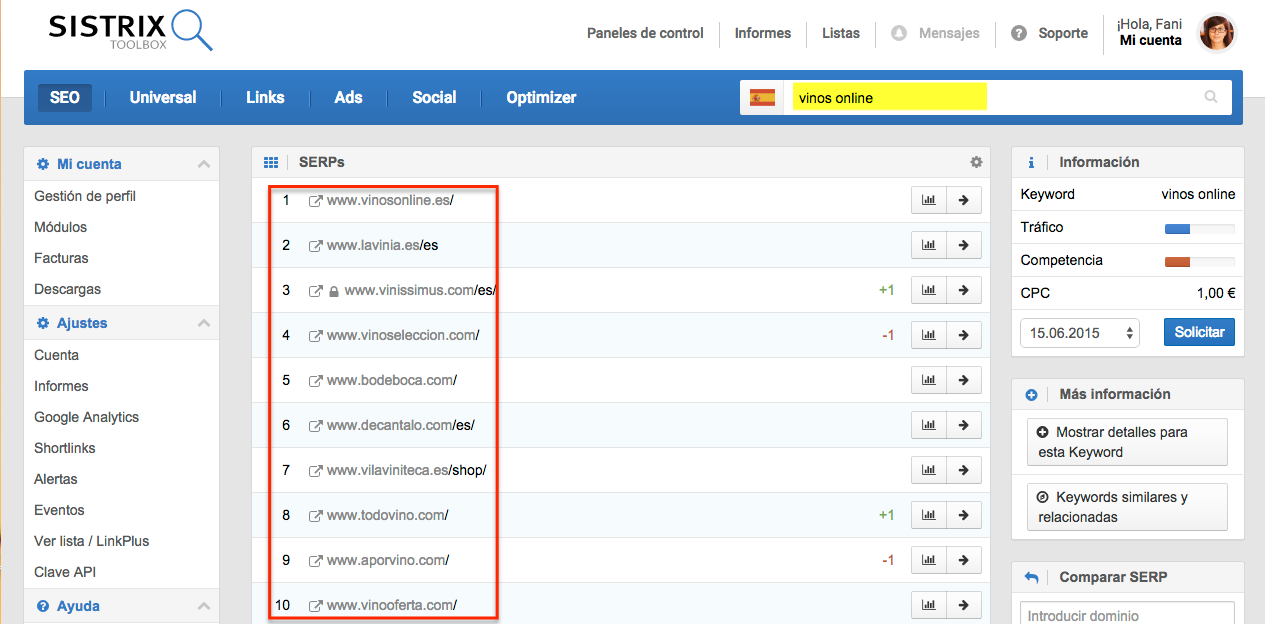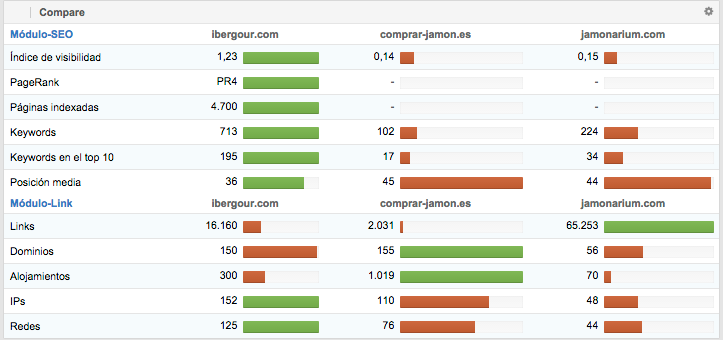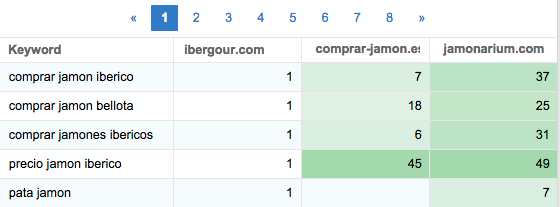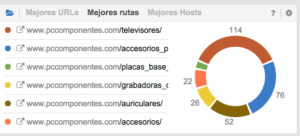Written by Fani Sánchez
Index
The study of competition in SEO is one of the main branches of analysis to establish or give continuity to a positioning strategy. It is the extension of the SWOT (Strengths, Weaknesses, Opportunities, Threats and Opportunities) from traditional marketing to online marketing, and often serves as a brainstorming tool and to be aware of our weaknesses or strengths to be strengthened.
There are multitude of tools with which we can study our competition in SEO. In fact, the ideal is to combine those that work best for cross-referencing data and pooling knowledge, but on this occasion we will focus on what we can do by studying our competitors with the tool Sistrix.
Here we go!
Who is my competition?

To define our SEO competition we must ask ourselves: who is my REAL competition in the ONLINE world?
Although we must not lose sight of our ultimate goal, in this race for the top ranking we have to set ourselves achievable targets and also compare ourselves with competitors that match our reality. Therefore, among our competitors we will choose domains whose online project has similar dimensions to ours, and optionally, we can also choose a larger competitor to which we aspire to be similar, although this will mainly help us to guide us in our strategy and discover strong points to imitate.
Discovering my competition with SISTRIX through keyword positioning
The SISTRIX tool can also help us discover our competition if we are really lost on the subject. Choose a word for which you aspire to rank, such as “online wines” and enter it in the search box; the tool will return which domains are ranked for that keyword up to a limit of 100 (those that occupy the first ten pages of Google positions).
From this functionality we can extract several names of competitors and judge, at our choice, and based on the content and dimensions of a portal, which are our real competitors.
Discover my competition with SISTRIX through the SEO Module > Competition
By entering your domain name in the box and going to the SEO Module > Competition, SISTRIX will list some domains that it considers to be direct competitors of yours based on the keyword match with respect to the positioning of your website.. This is a very logical idea, but there are many cases in which this premise does not work and I prefer the first method. For example, what if my domain has a short life span, what if my positioning is so low that it does not register data? Not to mention Wikipedia, which as many will know, in 90% of the cases will turn out to be my competition. Personally I consider that It is advisable to start from the least automated point possible when it comes to establishing our competence.
Not automating the search process for our competitors will save us some surprises.
An overview of the competition
Once we have chosen our competitors and to get an overview of the status of our domain against the competition, we can use a feature of the search box that consists of entering my domain along with the chosen domains, separated by commas. However, only the root of the domain. This command does not support comparisons between subdomains or subdirectories. We have previously chosen our competition and we are going to enter the following sequence in the box: ibergour.com, comprar-jamon.es,jamonarium.com, which will return a summary of the indicators that the tool collects in its five modules (SEO, Social, PPC, Universal Search and Links). It will mark in red the indicators of the “losing” domains and in green that of the “winning” domain.
For example, in the screenshot, the domain ibergour.com has an advantage over its competitors in the SEO module but nevertheless in the link module the graph indicates that we have a disadvantage in terms of domain variety or number of links compared to our competitors, so it would be a weakness to study in a more specific analysis of the competition in terms of popularity.
Keywords in common with our competitors
To find out for which keywords you are competing with other domains, go to the SEO Module > Competition and click on the keywords button. The tool will ask us to enter the domains we have chosen as competitors, the maximum allowed being three.
This section only offers a numericalquantification , and in this sense there are other more interesting tools to use to get the details of this information, as we told you previously in this article of our blog.
As we can see in the screenshot, the colored data indicates the total keywords for which the domains are ranked in the Top 100. Ibergour.com 713 words, Comprar-jamon.es 102 etc. If we continue crossing rows and columns we will find the keywords that each domain combination has in common: 84 words have in common ibergour.com with comprar-jamon.es, 141 if we talk about ibergour.com and jamonarium.com, etc.
Compare the positioning of our keyword rankings
If in the same menu we click on the “Compare Keywords” button and enter the competitor’s domains, we will obtain as a result a complete table with the following results the complete bulk of our positioned keywords is listed in rows, in descending order (first words in first position first) and in columns, the positions of each of our competitors for that keyword.. This list cannot be filtered or downloaded, so it is also somewhat limited.
The colors are placed to facilitate a quick overview of the situation. Only the results of the competition will be colored: green for the domains that obtain worse results than us (the less intense green being the best positioned and the darker green the one that obtains worse results for the keyword in question) and red if the colored domain in question is better positioned than us.
A twist

I recommend you to visit several of the sections offered by SISTRIX and contrast our indicators with those of our competitors, at the highest level of detail you can.
Cross-checking data and establishing differences
Analyzing and downloading separately our positioning and that of our competitors, I recommend creating a master Excel document where we can cross-reference all types of data with formulas and vertical searches. I can’t say enough that spreadsheet programs are our friends.
By downloading keyword data and crossing our data with those of our competitors, we can check which URLs compete for the same keyword and establish differences.
For example, download from Sistrix the list of positioned keywords, for us and for our competitors. This list is interesting because it includes the URL field that opts for positioning with each keyword. By downloading in Excel and cross-referencing data with functions such as SEARCHV or organizing the information with pivot tables we can know which URLs compete for the same keyword and establish differences between me and my competitors. What do they do and I don’t?
- How is the keyword density on that page?https://support.microsoft.com/es-es/office/crear-una-tabla-dinámica-para-analizar-datos-de-una-hoja-de-cálculo-a9a84538-bfe9-40a9-a8e9-f99134456576?ui=es-es&rs=es-es&ad=es&fromar=1
- What is your title, your hierarchy of headings, the length of your content?
- What labeling does your source code contain?
- How is the page linked on the site?
- How many external links do you receive?
Directory analysis and comparison
This menu appears in two ways: as a module in the main tool summary and in the left side menu.
The above screenshot corresponds to the first area described. There are two types of presentations in the chart: the listing of the best routes, which lists in descending order those with the highest visibility, and the graph, which does not always coincide with the listing next to it, summarizes the number of keywords for which each directory is positioned.
If we go to the directories section in the side menu we will also be able to:
- Discover competitor directories that work very well and we probably didn’t know they had: glossaries with vocabulary, directory with a list of relevant information for the site, product reviews, frequently asked questions… A complete and extended list is offered.
- Check the differences between common directories. If we have directories in common (tags, categories, services…), we can discover them here and proceed to investigate their visibility in the next point.
- Download keyword lists and benchmark our sites against yours
- Check the evolution of your visibility. Clicking on “analyze path” above the directory, it will take us to the general summary of this one, being able to edit the visibility graph to add (Configuration wheel > Compare data in the graph) the directories, domains or subdomains that compete with mine, giving rise to a graph like this one:
Analysis and comparison of subdomains
The Hosts section of the left side menu has the same purpose, focusing on subdomains instead of subdirectories. Its function is to discover which are the most popular subdomains of your competitors. Are there any you didn’t know about? Does it suggest any ideas applicable to your site?
Visibility analysis and comparison
With Sistrix, we can analyze visibility at the page, directory or subdirectory level. Cross-referencing the data on the graph with our competitors should give us clues as to whether we are going in the same direction as them, and if not, find out why using the functionalities already discussed here combined with third-party tools.
If there are sudden changes in visibility, it can be due to a multitude of factors, as the Sistrix visibility index is based on SEO indicators, but also PPC, Social etc. Some examples that could cause abnormal visibility rise:
- Growth of social signals due to the publication of some very viral content.
- Increased indexing due to product catalog expansion or resolution of previous crawling problems.
- Growth of popularity by the creation of natural links generated by a particular action.
- Google algorithm updates that change the positioning of our site and therefore, its visibility graph.
Some of the causes of a variation in the visibility of our competitors will not be easily verifiable, but for others, we can use third-party tools that will complement our information in this regard:
- Use Majestic SEO, ahrefs or any other popularity tool to check for link growth.
- We can run the site: operator in the Google search bar periodically to check the variation in indexing, although it is an unreliable indicator.
- Use Wayback Machine to check if there have been any content or code changes on the page.
- Go to a compilation such as MOZ to check if there have been any recent algorithm changes.
To analyze sudden changes in the visibility of the competition, it is advisable to complement the study with third party tools.
Conclusions
As you can see, Sistrix can be a very complete tool if you are clear about what you are looking for and you refine your conclusions with surgical precision. In the“Keyword Consulting” article we will go into more depth, but for now, I leave you with the fundamental recommendations that can be extracted from this article:
- Use the filtering tools to segment the data more precisely.
- Download the data into Excel to multiply the power of the analysis.
- Cross-reference your data with those of your competitors.
- Whenever necessary, supplement this data with data provided by other tools.









